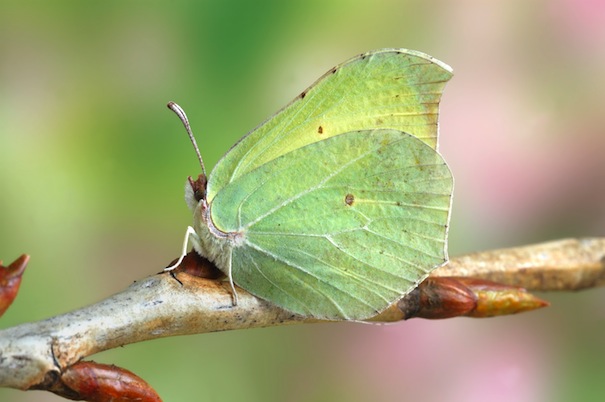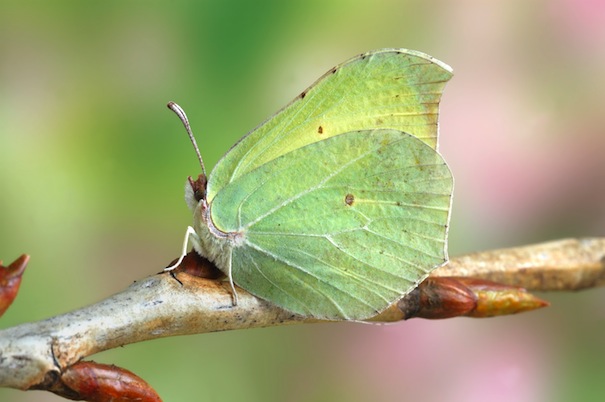
Edward Andrews welcomes the year’s first butterfly – the Brimstone or Queen of Spring – which finds shelter in the evergreen foliage of winter ivy.
There is an old sunken footpath near Church Stretton that follows a narrow valley. The path is rocky and eroded from water gushing down from the hills above. Old hazel trees line the path, many clothed in ivy which hangs like bunting from the branches. In midwinter, with the trees stripped back to their skeleton, ivy provides a welcome splash of green – it seems to soften the harsh landscape. I emerge from the woodland and follow a path alongside a hedge; a huge ash towers above me. Ivy has also spiralled through the crown of this tree. On large trees like this, I have seen ivy stems thicker than your wrist and covered in dense brown hairs.
Just beyond the ash, I come to a sunny spot near a gate. Ivy has completely engulfed the hedge and is a mass of dark berries, a veritable feast for birds in the winter months. The berries start life as flowers in the early autumn, covered in hoverflies and other insects, drinking up the nectar. Ivy only produces flowers in sunny conditions. The young ivy’s leaves are the traditional ‘maple’ shape with triangular lobes. As the plant matures and produces flowers, the leaves lack these lobes.
Nature’s growing acrobat
If you ask many old woodsmen, they would class ivy as a parasite that strangles trees… but the picture is rather more complicated than that. Ivy is an epiphyte: it requires a support against which to grow but does not steal nutrients. Aerial roots help the ivy to adhere to walls and trees. I remember learning about the idea of ‘tropisms’ and being fascinated by the concept. Using specialised cells and hormones, plants can sense an external stimulus and react accordingly. The tips of plant stems will grow towards sunlight (phototropism). The roots will naturally grow down into the ground in response to gravity (geotropism). Ivy exhibits ‘thigmotropism’ which means it can ‘touch’ and locate a tree or wall upon which to grow.
First butterfly of spring
If you peer amongst the glossy leaves of ivy in the winter months, you may find an over-wintering brimstone butterfly. It is easy to think of butterflies as fragile insects purely of high summer, but the adult brimstone can actually live for 12 months and toughs out the British winter by sheltering in the dense foliage. These insects have an exquisite wing shape that perfectly resembles an upturned ivy leaf, giving them valuable camouflage. The brimstone is often the first butterfly to be seen in late March or early April. The male insect is first to emerge. They are a bold yellow colour and strong fliers. They can often be seen resting with their wings at right angles to the sun, gaining as much warmth as they can.
The female insect emerges slightly later to mate; she lays eggs on alder buckthorn shrubs. The caterpillars hatch and feed on the leaves, then moulting their skin as they grow and, after a month, pupating. After two weeks in a cocoon the adult butterfly emerges. This generation of butterflies must feed heavily on nectar-rich plants in order to get ready for hibernation.
Balanced strategy
Ivy can, of course, have a detrimental effect on trees. The extra weight and wind resistance can increase the likelihood of trees being blown over. Ivy can also mask diseases and fungi that may be present on the tree. However, in many modern woodlands, ivy is a significant source of late-season nectar. As well as being a valuable plant for butterflies, it also provides shelter for roosting tawny owls, cover for nesting birds and a range of other wildlife benefits. Therefore, ivy management requires a balanced strategy. On particularly vulnerable trees, ivy can be severed at the base to make it die back. On other trees, the ivy can be left to flourish.
If it is a sunny day as you finish reading this article, take a walk and see if you can spot a brimstone butterfly. The first sighting is a sure sign that the weather is warming up. John Clare described the butterfly as the ‘Queen of all the insect race’. The queen of spring is emerging from her evergreen palace; rejoice!
Do one thing for wildlife this month
Spring’s a great time to plan a new feature in your garden. Why not create a butterfly border in a sunny spot? Remember most butterfly species have different food requirements as caterpillars and adult butterflies. In the case of the brimstone, caterpillars feed on alder buckthorn leaves whilst adult butterflies feed on flowers such as primrose and marjoram. If you have space, why not allow some ivy to become established too? For more information, take a look at the excellent gardening section of the Butterfly Conservation webpage:
www.butterfly-conservation.org/292/gardening.html
Each month, What’s What! nature expert, Shropshire Council’s Parks and Countryside Sites Officer, Edward Andrews, looks at the changing seasons around us.






